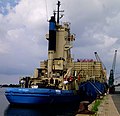Push convoy
A push convoy is the temporary combination of a push ship with one or more barges .
The aim is to separate the propulsion section of the ship from the cargo hold. It is also available while the barge is still being loaded or unloaded. In principle, several barges are put together like a construction kit to form a push convoy, which is then only driven by a push boat. A port push boat then maneuvers a single barge to its destination. In addition to flexible loading, this combination of barges also enables cost-intensive push boats or several ships with their own drive to be saved. On the Danube and the Rhine , push convoys with two to six barges are used, while on the Mississippi more than 70 barges are coupled together with the largest push convoys. Push convoys are found almost exclusively in inland shipping .
Shape of the hull
The push boat and the barge have a rectangular floor plan above the waterline, except for small rounded corners. The side walls, as well as the bow and stern, are flat and run vertically up to the beltline, which ensures that when adjacent parts of a structure - above deck - are lashed together with steel cables, they are practically immovable. To ensure that an unloaded barge that emerges far out of the water has a good thrust connection, push boats that lie more consistently deep in the water have two shoulders that run vertically upwards about 2 m flush with the bow wall. Such shoulders at the stern and bow are lighter. These run down a little and sometimes even plunge a little into the water when they are fully unloaded, whereas behind them the hull is already sloping back twice.
Lashing and maneuvering
They are firmly lashed together using a steel cable typically more than 30 mm thick, from bollard to bollard of the neighbor, using a winch. It is lashed twice on the colliding long sides of the barges, and twice on the narrow ends of the barges and the bow of the push boat - each near the corners of the decks.
The long, lean combination of a certain number of barges is somewhat more aerodynamic in terms of the energy efficiency of the drive, but is more difficult to maneuver around curves. The internal dimensions of lock chambers must be taken into account as a limit, splitting or reclamping the association may be necessary. Any existing rudder blades (usually in pairs) or bow thrusters at the front of leading lighters help when maneuvering in river bends, when mooring and in port. The maximum flow speed in the driving line limits the total load for a push boat with a certain thrust.
Wave generation
Push convoys typically move larger units than tow convoys or single ships and generate higher waves at correspondingly long voyages, which small ships must be careful of. With regard to a high overall efficiency when going up and down the river, push boats also use a higher engine power upstream against the current than downstream. Even if they appear to be moving more slowly upstream than opposite the bank, because they approach against a strong current, they have a higher speed compared to the water and therefore generate the stronger bow and stern waves here too. These can lead to capsizing in the vicinity, when ascending to shallower river spots or through surf on the bank or pier for small ships or paddle boats.
Comparison with other procedures
The towage - to about 1,980 still the predominant form of transport on the upper Austrian Danube - was carried out by a loose bracing with steel cable. Since the towed barges are in the downstream of the drive screw of the tug, a distance of about half a ship's length was maintained here - for reasons of efficiency - which, however, could be reduced for passage through the lock. The tow rope was articulated roughly in the middle of the tugboat so that it could maneuver more freely. Since the rear section is therefore swept over by the rope, it was spanned by repellent pipe bends under which people could move. Also between the barges, which had a slightly tapering bow and stern, a little distance was maintained and a little flexibility was created by tensioning with two ropes in an X shape. When traveling downhill, a tug convoy had to run out of its own accord to enter a lock, while a pushed convoy can also be actively braked with a push boat on the train.
In the chain shipping industry around 100 years ago , maneuvers were necessary to pick up and put down the chain lying in the river and encounter traffic was made more difficult, but - upstream - relatively small steam engine outputs were sufficient, since the drive was not supported by the water flowing away, but by an anchored chain.
Push convoy with 28 barges on the Mississippi near Memphis (Tennessee)
Push convoy with four empty barges in Leutesdorf to the valley, beveled barge ends each oriented as bow and stern of the convoy
Sea-going push convoy Mega + Motti of the shipping company Briese
See also
literature
- Hans-Wilhelm Dünner, Horst-Christian Knoll: 50 years of the German inland shipping company. Koehlers Verlagsgesellschaft , 1999, ISBN 3-7822-0757-2


